Get started with Strategic Growth Hacking Operating System
A process guide for Strategic Growth Hacking Operating System and Growth Dashboard by Mari Luukkainen.

This is a process guide for Strategic Growth Hacking Operating System.
Do you have difficulties to follow the process? Contact my agency Truly.
Set your direction
Make yourself a copy of Growth Dashboard Lite.
You can also use different project management tools for your goal and progress tracking, but I use Growth Dashboard as the one place where I gather all the important growth related information to help my decision making.
First we set up our direction by filling up the OKR sheet.

- Choose a meaningful Strategic Goal. If you operate in a cross-functional Growth team this is usually a revenue goal. If you operate as a part of a specific function, it can be related to the amount of leads (growth marketing), amount of produced content (content marketing), amount of closed deals (sales), quality of applicants (talent), satisfaction of employees (HR) etc.
This will be the north star of your growth development and all your experiments and tasks should focus on improving the Strategic Goal.
Read more about OKRs. - Split your Strategic Goal into actionable sub-goals. For instance a typical B2B revenue is a combination of lead acquisition (marketing), sales performance (sales) and retention (customer success).
These will be your areas of actual actions you'll take to improve the north star. - Assign each area of responsibility an Owner.
These individuals should be your team of growth development you collaborate with to have an impact on the north star.
💡 Tip: Growth hacking is about testing and learning. Your Strategic Goal and subgoals can change during testing. Review them monthly or quarterly to make adjustments. Don't let a decision of "perfect OKRs" block you from starting testing!
Define your ICP (Ideal Customer Profile)
Next we want to gather all the information we know about ICP (Ideal Customer Profile) to one place.
Fill up the ICP sheets with all the information you're able to gather in a reasonable amount of time.
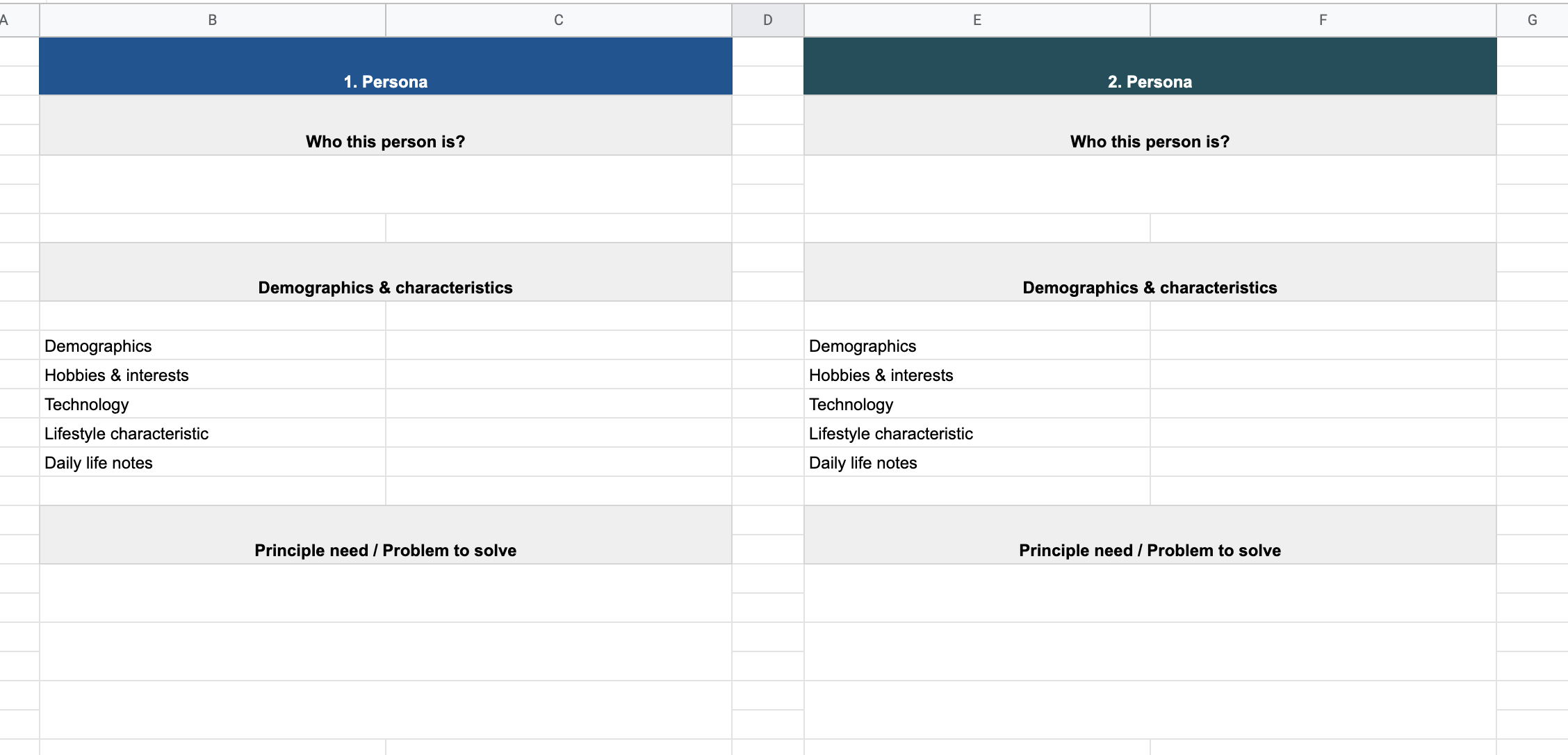
Information about ICP and messaging is usually scattered in different documents and individuals, and we want to collect everything in one place to set up a foundation of ICP iteration.
Use different tactics depending on what you've available: data analytics (Google Analytics, advertising platform's analytics), surveys, interviews and interview also the employees of the company. Founders, and people working in Sales and Customer Success have usually the most accurate insights.
💡 Tip: Learning from your ICP is an iteration. While you experiment, you will learn something new all the time, unlock new audience types and may even ditch the one you started with. Create a habit of collecting information here all the time when you learn something new.
💡 Tip: If you're just starting and you know absolutely nothing about your ICP, start by drafting your best hypothesis based in your common sense.
Setup your analysis foundation
Next we want to setup a foundation of data-driven decision making.
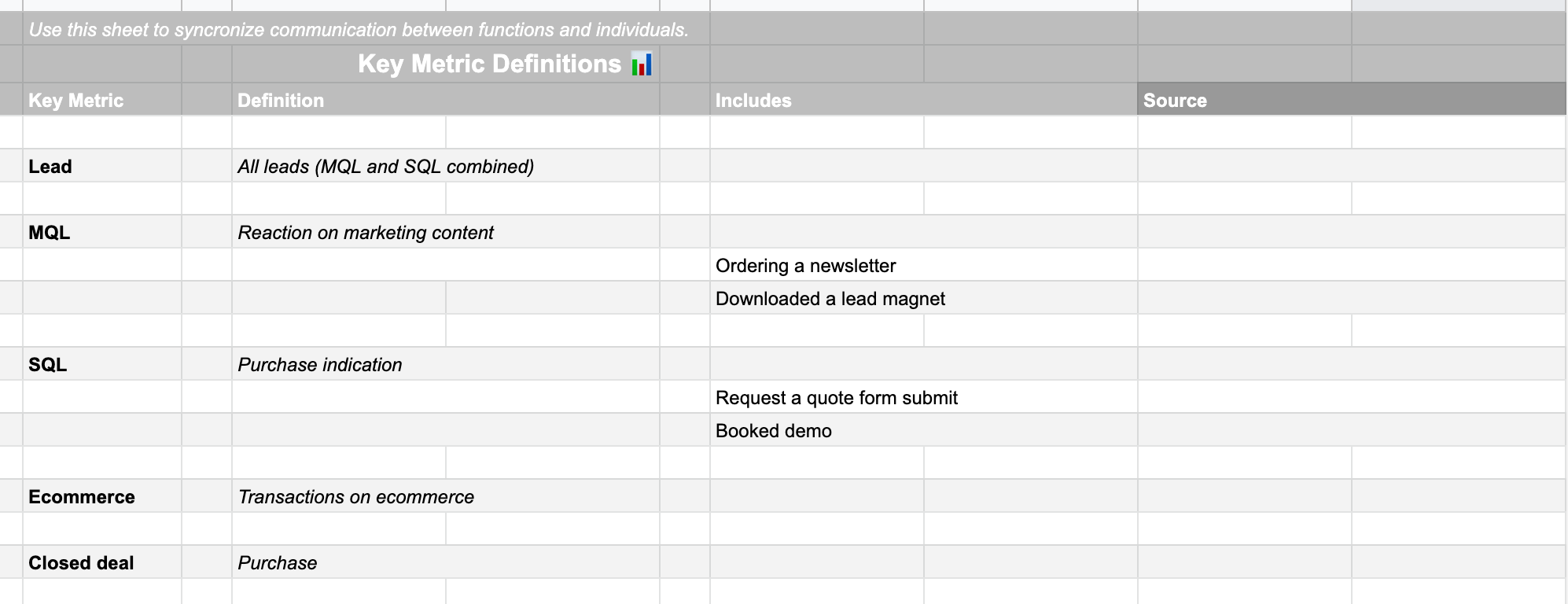
First fill up the KPI Definitions sheet to synchronise communications between functions and individuals. This will improve communications between functions in the future (e.g. marketing and sales has the same definition for "lead").
Remove the definitions that are irrelevant for your business and add the ones that are relevant.
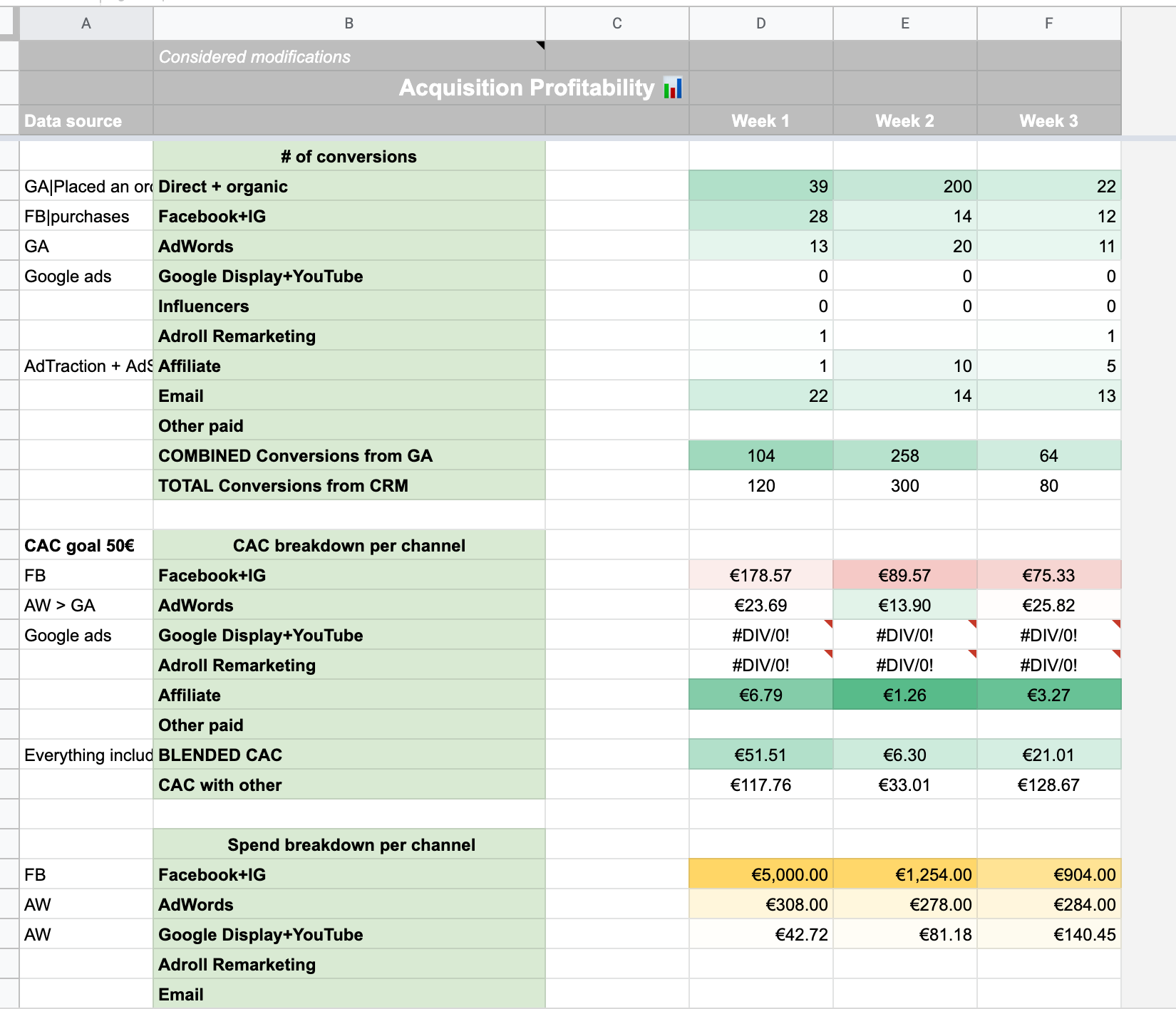
Then fill up the Acquisition Profitability sheet to understand what is the benefit of our acquisition investment.
You can use this sheet manually or by automating it with Supermetrics.
Due to GDPR's impact on attribution, you may not be able to generate 100% accurate data for each section. I recommend to focus on Combined Conversions on your CRM and Blended CAC.
✨ To have the most accurate understanding for your CAC, include also other costs that have an impact on acquisition, such as salaries, outsourcing, tools and offline-costs.
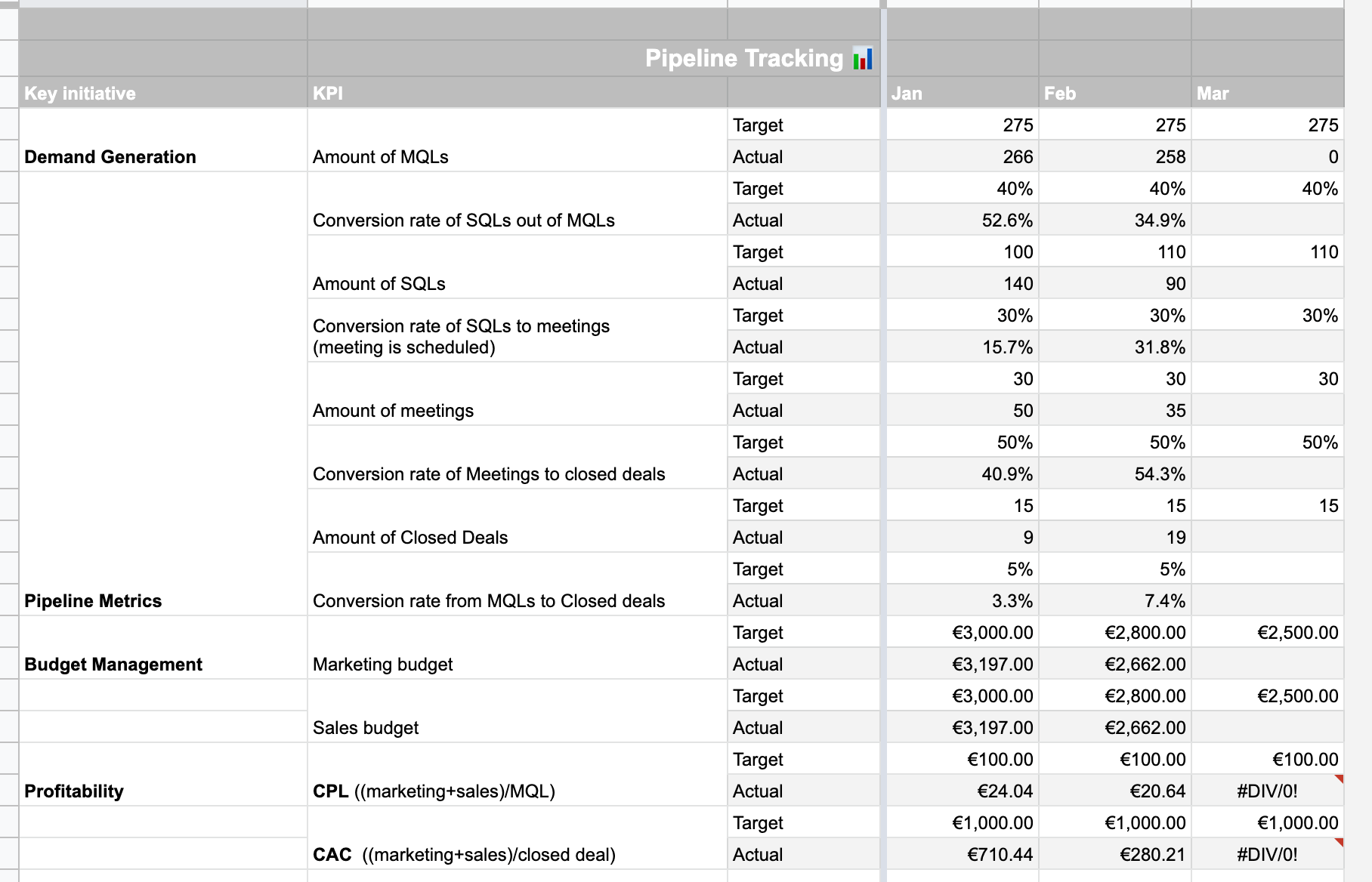
🏢 B2B company with a Sales function: fill up Pipeline Tracking together with Marketing and Sales.
Pipeline visibility will help you to analyse your pipeline efficiency. In most cases maintaining this sheet will need a process implementation as addition to technical data points, e.g. Sales reporting the demos manually.
💡 Tip: While filling up these sheets, you may find missing data points or missing processes to collect data. Data management is also an iteration: start with what you're able to gather and continue adding data points and building processes in following weeks. Remember to make some time for data sanity checking every now and then.
Setup your first experiment
After setting up your direction, gathering information about your IPC (Ideal Customer Profile) and setting up a foundation for analysis, you should now have some kind of ideas on how to start experimenting to improve your OKRs.

Setup your first experiment on the Experiment sheet.
What you want to achieve is a meaningful experiment you think that would improve your OKRs from the OKR sheet based on your best understanding right now.
Optimal Experiment is
- Linked to your OKRs. This process should help you to focus only on the things that matter, so consider twice the experiment ideas that don't have any impact on your OKRs.
- Something you think you're able to execute within a week. This process accelerates learning, so set up an experiment that can deliver you a learning within a week.
- Measurable, so you're able to analyse if the experiment was successful or not.
- Learnings focused. We are focused on learning experiences, so a valuable learning is also that you were not able to execute the experiment within a week or it was a failure. Don't be afraid of taking some risks.
Launch your first experiment and document tasks
To make sure your experiment gets executed, especially if you need multiple people to build it, document experimentation related tasks on a Tasks sheet with Owner who is accountable for certain tasks.

💡 Tip: If the Owner was somehow blocked and couldn't finish their task, track the reasons in Notes. Weekly iteration cycle of this process is designed to reveal different internal bottlenecks to understand what kind of resources we're lacking that prevent our growth (e.g. talent or outsourcing).
Analyse and update numbers
After a week or similar timeframe your Experiment should be executed.
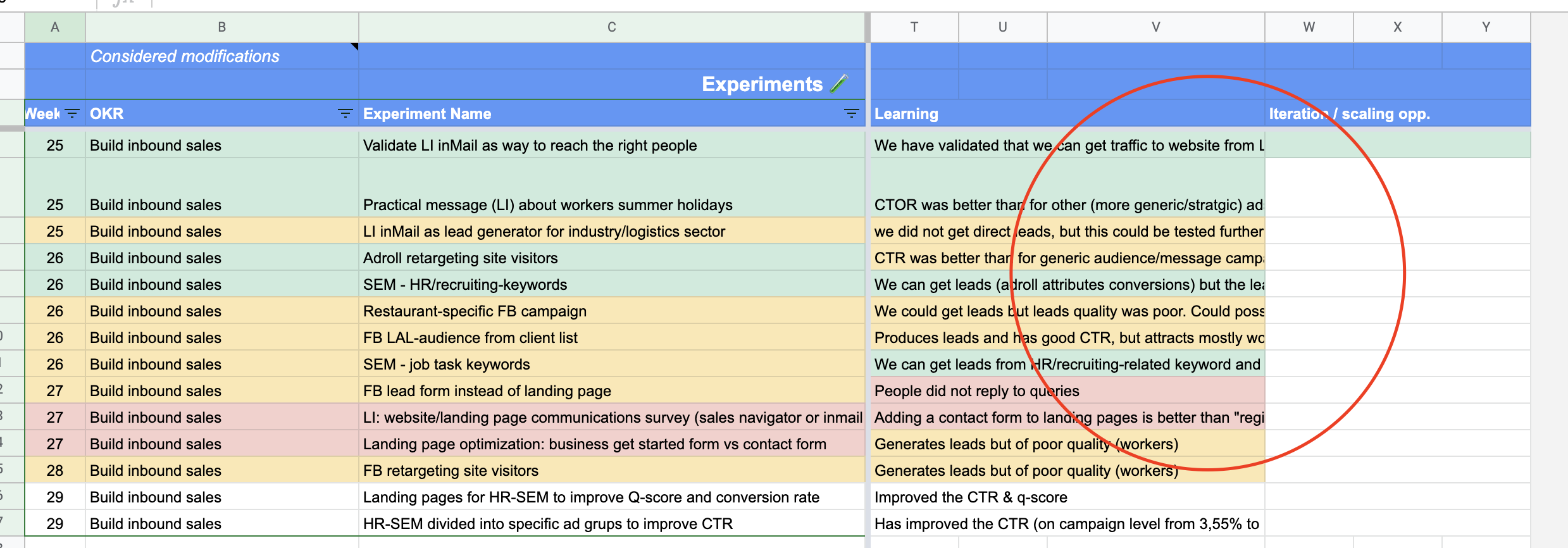
Start by analysing the Experiment metrics and document the Learning on Experiment sheet. Add also notes if you come up with iteration or scaling ideas.

If your Experiment already provided an improvement on your main OKRs, update that as well.
💡 Tip: Did you learn something new regarding to your ICP? Update that sheet as well!
Communicate
Communicate your experiment and learnings to your company on a weekly basis to make testing transparent. Recommended channel is Slack or a similar place where others can ask questions and give ideas.
Weekly report example:
Hi everyone! Here's what happened in growth hacking during last week.
Main KPI: 26/100 new leads 🔥
Last week we tested a LinkedIn inmail campaign targeted to CMOs in companies of 100 people because we noticed there's one extremely active CMO in our current customer base.
Learning: We got one lead and the campaign CTR was 60% so this seems like a promising lead acquisition method.
Based on the campaign performance I decided to continue testing by doubling the budget for this week to see if we're able to double the lead amount.
@Sales, can we quickly check the lead quality so we know I'm on the right track?
Here's the link to the Dashboard if you want to check more details: [Spreadsheet link]
Continue to the second experiment
Based on the results and analysis you can now continue to set up your second experiment. If you're out of ideas, sparring with individuals within your company or other professionals helpsPages. It could also help if you just write it down and explain your findings to yourself.
Remember that we're focusing on learning experiences. Everything you find out about the experiment itself or your company's internal capabilities of executing experimentation are valuable learnings about bottlenecks preventing your growth.
Read more
Get started with cross-functional growth hacking used in hundreds of startups in Nordics and Baltics.
